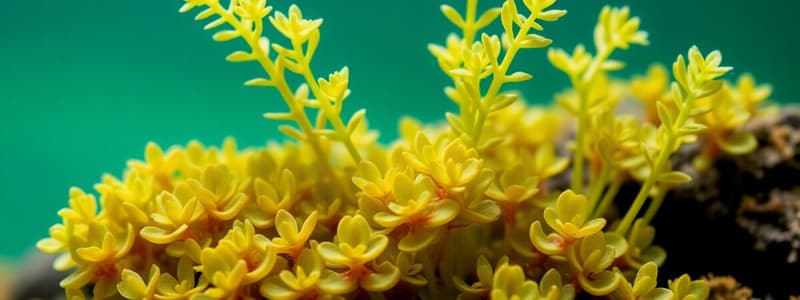Podcast
Questions and Answers
What is the primary function of the large air spaces in aquatic plant leaves?
What is the primary function of the large air spaces in aquatic plant leaves?
- To store nutrients for the plant
- To provide buoyancy and facilitate floating (correct)
- To prevent excess light absorption
- To absorb water efficiently
How do the roots of aquatic plants differ from those of xerophytes?
How do the roots of aquatic plants differ from those of xerophytes?
- Aquatic roots do not attach to the substrate (correct)
- Xerophyte roots are designed to float
- Xerophyte roots are shallower
- Aquatic roots are deeper and more branched
What feature of xerophyte stems helps reduce heat absorption?
What feature of xerophyte stems helps reduce heat absorption?
- Their green color due to chlorophyll
- Their succulent nature
- Their large surface area
- Their upright shape (correct)
Why do aquatic plants have a thin cuticle on their leaves?
Why do aquatic plants have a thin cuticle on their leaves?
What adaptation do xerophyte leaves possess to minimize water loss?
What adaptation do xerophyte leaves possess to minimize water loss?
What is the purpose of the stomata being located on the upper surface of aquatic plant leaves?
What is the purpose of the stomata being located on the upper surface of aquatic plant leaves?
Which of the following is NOT a characteristic of the roots of xerophyte plants?
Which of the following is NOT a characteristic of the roots of xerophyte plants?
Which adaptation of aquatic plant stems helps them withstand water currents?
Which adaptation of aquatic plant stems helps them withstand water currents?
Flashcards
Aquatic Plant Roots
Aquatic Plant Roots
Roots of aquatic plants do not attach to the river/pond bed to prevent being cut by currents.
Aquatic Plant Stems
Aquatic Plant Stems
Aquatic plant stems are elastic and contain air spaces to help the plant float for photosynthesis.
Aquatic Plant Leaves
Aquatic Plant Leaves
Aquatic plant leaves are large, have air spaces for buoyancy, thin cuticles, and little lignin in the xylem; they float on the surface for efficient light absorption, with stomata on the upper surface to allow gas exchange but prevent water entry.
Xerophyte Roots
Xerophyte Roots
Signup and view all the flashcards
Xerophyte Stems
Xerophyte Stems
Signup and view all the flashcards
Xerophyte Leaves
Xerophyte Leaves
Signup and view all the flashcards
Study Notes
Aquatic Plants
- Roots: Do not attach to the river/pond bed to avoid being cut by currents.
- Stems: Elastic to resist water currents; contain air spaces for buoyancy.
- Leaves: Large air spaces for buoyancy and gas diffusion; thin cuticle (no need to reduce water loss); little lignin in xylem (supported by water); float on the surface for efficient light absorption; stomata on the upper surface to allow gas exchange and prevent water entry.
Xerophyte Plants
- Roots: Deep to access water at greater soil depths; branched to increase water absorption surface area.
- Stems: Upright shape to reduce heat absorption; succulent to store water; green (contains chlorophyll for photosynthesis).
- Leaves: Very small, spine-like to minimize water loss, prevent wind rupture, and protect from herbivory; fewer stomata to reduce water loss; hairs to decrease airflow and increase humidity.
Studying That Suits You
Use AI to generate personalized quizzes and flashcards to suit your learning preferences.




